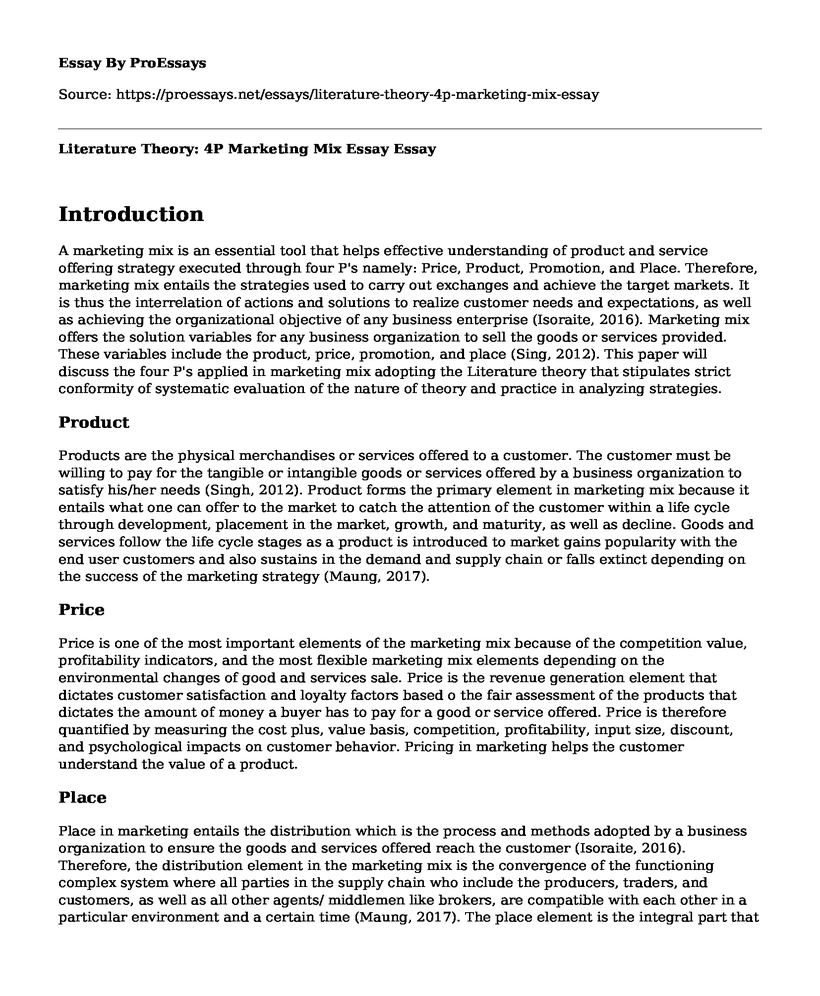Introduction
A marketing mix is an essential tool that helps effective understanding of product and service offering strategy executed through four P's namely: Price, Product, Promotion, and Place. Therefore, marketing mix entails the strategies used to carry out exchanges and achieve the target markets. It is thus the interrelation of actions and solutions to realize customer needs and expectations, as well as achieving the organizational objective of any business enterprise (Isoraite, 2016). Marketing mix offers the solution variables for any business organization to sell the goods or services provided. These variables include the product, price, promotion, and place (Sing, 2012). This paper will discuss the four P's applied in marketing mix adopting the Literature theory that stipulates strict conformity of systematic evaluation of the nature of theory and practice in analyzing strategies.
Product
Products are the physical merchandises or services offered to a customer. The customer must be willing to pay for the tangible or intangible goods or services offered by a business organization to satisfy his/her needs (Singh, 2012). Product forms the primary element in marketing mix because it entails what one can offer to the market to catch the attention of the customer within a life cycle through development, placement in the market, growth, and maturity, as well as decline. Goods and services follow the life cycle stages as a product is introduced to market gains popularity with the end user customers and also sustains in the demand and supply chain or falls extinct depending on the success of the marketing strategy (Maung, 2017).
Price
Price is one of the most important elements of the marketing mix because of the competition value, profitability indicators, and the most flexible marketing mix elements depending on the environmental changes of good and services sale. Price is the revenue generation element that dictates customer satisfaction and loyalty factors based o the fair assessment of the products that dictates the amount of money a buyer has to pay for a good or service offered. Price is therefore quantified by measuring the cost plus, value basis, competition, profitability, input size, discount, and psychological impacts on customer behavior. Pricing in marketing helps the customer understand the value of a product.
Place
Place in marketing entails the distribution which is the process and methods adopted by a business organization to ensure the goods and services offered reach the customer (Isoraite, 2016). Therefore, the distribution element in the marketing mix is the convergence of the functioning complex system where all parties in the supply chain who include the producers, traders, and customers, as well as all other agents/ middlemen like brokers, are compatible with each other in a particular environment and a certain time (Maung, 2017). The place element is the integral part that makes the goods and services accessible and physically distributed products attributed to the technical feasibility, transportation, local conditions, and availability of alternatives.
Promotion
The promotion element of the marketing mix helps to increase customer or end-user awareness of the products or services provided by an organization as a sale increasing strategy as well as brand loyalty building (Isoraite, 2016). This entails advertisement, personal selling, direct marketing, and public relations. This marketing mix element entails dissemination of information to encourage purchase and promote customers decision making to support the produced goods on persuasive sale promotion.
Conclusion
Conclusively, the marketing mix entails the decisions and actions geared towards any business organization meeting customer needs and expectations. Adaption of the four P's element as a complete marketing mix helps identify the essential needs on market identification, cost, awareness as well as accessibility.
References
Isoraite, Margarita. (2016). Marketing Mix Theoretical Aspects, International Journal of Research - Granthaalayah, Vol. 4, No. 6: 25-37.
Maung, Nyan Linn. (2017). Customers' Perceptions On Marketing Mix Of Sat Premium 2 Condominium In Yangon, Independence Study Global MBA Batch (5) p. 13-18.
Singh, M. (2012). Marketing Mix of 4P'S for Competitive Advantage. IOSR Journal of Business and Management (IOSRJBM). Volume 3, Issue 6 (Sep,-Oct.).
Cite this page
Literature Theory: 4P Marketing Mix Essay. (2022, Jul 15). Retrieved from https://proessays.net/essays/literature-theory-4p-marketing-mix-essay
If you are the original author of this essay and no longer wish to have it published on the ProEssays website, please click below to request its removal:
- Analysis of Dirt Bikes Competitive Forces
- Warehousing and Distribution Centers Essay
- Marketing Research and Consumer Behavior Paper Example
- Consumer Satisfaction Report Paper Example
- Essay Sample on Motivation in Organizations in Saudi Arabia
- Paper Example on 5 Steps to Effectively Use CR in Organizations
- Essay Sample on Global Strategies: Enhancing Competitive Advantage Across Borders







